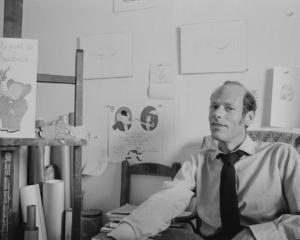A Crime in the Family, by Sacha Batthyany, is a deeply affecting page-turner depicting the massacre in March 1945 of 180 Jewish forced labourers on a Countess' estate.
A CRIME IN THE FAMILY
Sacha Batthyany
Quercus
Swiss-born investigative journalist Sacha Batthyany follows his German-language book, Und was hat das mir zu tun? (roughly, And what has that done to me?) with a more marketable title for English-speaking readers.

Although the title page in this edition promotes it as ‘‘a terrible secret from Europe’s darkest hour, a story told for the first time’’, the story has, in fact, been told in German and Hungarian a few times already, and by Batthyany (in magazine articles and a book).
It is a story, in part, of the massacre in March 1945 of 180 Jewish forced labourers working on last-stand defences on the estate of the author’s aunt, Countess Margit Thyssen-Batthyany, at Rechnitz on the Hungarian-Austrian border. That night they were forced to dig pits, then shot in the back of the neck by the guests, some of whom were German officers, after a drunken party at the Countess’ castle.
A Crime in the Family also expresses Batthyany’s sense of guilt about another incident on his great-grandfather’s estate at Sarosd, in the centre of Hungary, when a Jewish couple close to the Batthyany family were shot in front of his grandmother and the couple’s children sent to a German labour camp.
At the heart of the book, these two incidents are only the frame. Rather, the somewhat scatter-shot focus is on the writer’s own sense of guilt over the family’s failure to act to save Jews, as well as a wider, pervasive guilt among the grandchildren of supporters of fascism, along with the conscious closing of the eyes, ears and minds of others to atrocities being committed.
Batthyany weaves into his narrative of these wartime events extracts from two diaries, one written by his grandmother, who witnessed the death of the Jewish couple, and the other by the daughter of that couple, who survived the camps and later emigrated to Argentina.
In addition, Batthyany tries to come to terms with his angry and frustrated feelings for his own father, and with the memory of his grandfather, an officer in the Hungarian army fighting on the side of Nazi Germany who was captured by the Russians, spent 10 years in Siberian camps, returned to Hungary in 1955 then escaped to Switzerland after the Hungarian uprising in 1956 and later went to work for the Thyssen family in Germany.
With the rushing flow of many braided channels of deep-seated war-guilt it is little wonder that Batthyany spent some years in psychoanalysis in Zurich, an account of which also forms part of the current of this narrative.
The book is not a documentary entirely. There are passages of speculation, fiction, if you like, a style that knowingly constructs the story for reader interest; a tale of war, cruelty, riches to rags, rags to riches. Batthyany contrasts the tenacity with which some manage to hold on to life against the odds with the craving for forgetfulness of others. All of which makes for a deeply affecting page-turner.
- Peter Stupples teaches at the Dunedin School of Art.











